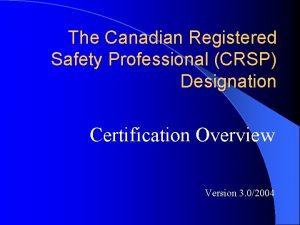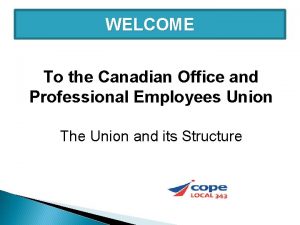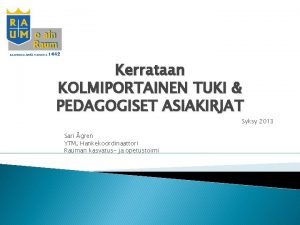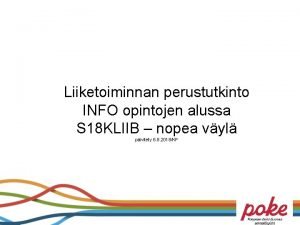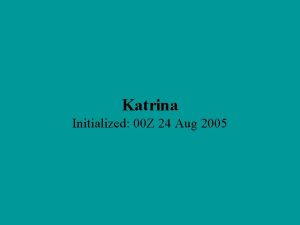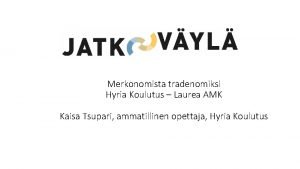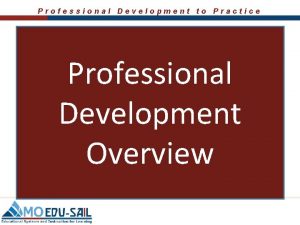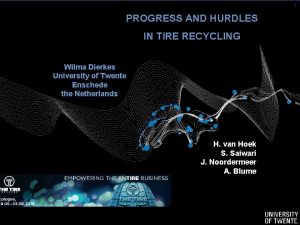XL DESIGN PROFESSIONAL Wilma Schreuders 68 th Canadian













































- Slides: 45

XL DESIGN PROFESSIONAL Wilma Schreuders 68 th Canadian Geotechnical Conference Quebec 2015 © 2015, XL Catlin companies. All rights reserved. I MAKE YOUR WORLD GO 1

XL Catlin – Fast Facts - Canada © 2013, XL Group plc companies. All rights reserved. I MAKE YOUR WORLD GO 2

XL Catlin • A publicly traded company on NYSE (stock ticker: XL) • *Shareholders’ equity of $11. 9 billion • * Total assets $45. 4 billion • Through its subsidiaries, a provider of: v Insurance and Reinsurance v Specialized commercial risk management solutions *As of December 31, 2012

XL Catlin • • • Serve clients in over 100 countries More than 1, 600 global programs Over 4, 000 employees 600 Underwriters…and growing 400 Claims Experts…and growing 200 Engineers…and growing

XL Catlin Segments in Canada • Casualty Ø Primary Casualty Ø Umbrella and Excess Ø Automobile • Environmental • Professional Risk Ø Directors and Officers Ø Professional Liability • Construction Ø Ø Ø Builder Risk Professional Environmental Surety Sub Contractor Default • Property Ø Power and Energy Ø Large HPR/Risk Managed • Fine Arts and Specie • Specialty Products Recall Equine Aviation Rail Marine Cyber and Technology Ø Political Risk and Trade Credit Ø Kidnap and Ransom Ø Terrorism Ø Ø Ø

XL Design Professional a Division of XL Catlin • 27 years in Canada • 40 years in USA • Specializing in Professional Liability for Design Professionals • Exceptional Claims Service • Industry leading Loss Prevention Programs 6

Risk Drivers: Classification of Causes • Technical Error and/or omission of a technical nature that results in a loss prevention file or claim • Non-technical Breakdown in project management processes or business practices that leads or contributes to a loss prevention file or claim 7

Top 4 Non-Technical Risk Drivers 45% Percentage of Claims Affected 39% 40% 2001 35% 2014 30% 27% 24% 25% 23% 20% 16% 15% 13% 10% 6% 5% 0% Negotiation and Contracts Client Selection © 2013, XL Group plc companies. All rights reserved. I MAKE YOUR WORLD GO Project Team Capabilities Communication 8

Comparative Claims Experience © 2013, XL Group plc companies. All rights reserved. I MAKE YOUR WORLD GO 9

Geotechnical Engineers © 2013, XL Group plc companies. All rights reserved. I MAKE YOUR WORLD GO 10

GEOTECHNICAL ENGINEERS Who Sues Geotechnical Engineers? © 2013, XL Group plc companies. All rights reserved. I MAKE YOUR WORLD GO 11

GEOTECHNICAL ENGINEERS Types of Damages © 2013, XL Group plc companies. All rights reserved. I MAKE YOUR WORLD GO 12

GEOTECHNICAL ENGINEERS Frequency & Severity (by project type) © 2013, XL Group plc companies. All rights reserved. I MAKE YOUR WORLD GO 13

WHY DON’T WE LEARN FROM EXPERIENCE? A simple process for improving your process delivery and profitability Bob van. Arsdall Director of Market and Sector Analysis XL Insurance’s design professional group 14

Agenda • I have to convince you why you need to do them • I have to show you how to do them • I need to help you overcome cultural barriers to them • I need to leave you with hope for change 15

Why you need post-project reviews © 2013, XL Group plc companies. All rights reserved. I MAKE YOUR WORLD GO 16

Changes in the A/E sector 2003 -2014 US & CA 90% 80% 70% 60% 50% 40% 30% 20% 10% 0% Employees 1 to 5 6 to 25 25 to 100 101+ Total Percent of Firms in Sector - 2003 Total Percent of Firms in Sector - 2012 Percent of Revenue by Size - 2003 17

What do these things have in common? • • • Design-Build Construction Management at-risk Public-Private Partnerships Integrated Project Delivery (IPD) Lean Construction 20

NIST Study on Construction Interoperability 2004 • “Cost Analysis of Inadequate Interoperability in the U. S. Capital Facilities Industry” (fire. nist. gov/bfrlpubs/build 04/PDF/b 04022. pdf ) • Identified inefficiencies in US federal DBB procurement amounting to $15. 8 B/year • Owners and operators shoulder 2/3 of this cost • 7% of total comes from designers 22

NIST findings • Software incompatibilities • Rework • Change Orders (from poor advance planning) • Poor logistical control 23

2006 – XL Group study • 8 design firms from varied disciplines and sizes • 6 -month study to identify and quantify causes of project write-offs • On average firms were writing off 5%7% of total project profit • Specific causes: • Rework • Scope creep 24

Canadian-Specific Studies • • University of Alberta – The Field Rework Data Collection • Over 16 papers from 1999 -2012 • Rework averaging 10% of total construction costs “Developing a standard methodology for measuring and classifying construction field rework”, Fayek, Dissanayake, Campero, Canadian Journal of Civil Engineering, 2004, Vol. 31, No. 6 : pp. 1077 -1089 25

One detailed Canadian study “Analysis of a Construction Small-Projects Rework Reduction Program for a Capital Facility”, Di Zhang, master’s thesis, Dept. of Civil Engineering, University of Waterloo, 2009, p. 83 Three contractors, $22. 34 MM contracted, 292, 929 total labor hours 26

2012 Navigant Construction Forum • Direct cost of rework is between 4. 03% and 6. 05% of original contract cost with a median of 5. 04% • For every dollar of direct cost there is an indirect cost of almost 80% • Including indirect costs results in a total range of 7. 25% to 10. 89% with a median of 9. 07% (“THE IMPACT OF REWORK ON CONSTRUCTION & SOME PRACTICAL REMEDIES” Navigant Consulting, August 2012) 27

More Navigant findings • Schedule impact of rework • Average delay is approximately 19% of original project schedule • Result is 9. 82% schedule growth (72 days on a two-year project) • Trend is going up! • 20 studies between 2002 -2011 demonstrated 3% growth 28

Navigant suggestions • Use of BIM and Virtual Design & Construction (VDC) • Early and continuous stakeholder involvement • Design freeze prior to start of construction • Bid-ability review • Necessary due to unclear scopes • Different interpretations of project requirements 29

Lessons here • You may be doing excellent design work, but you aren’t addressing the owners’ real needs. • You may have your firm under control, but the entire design and construction sector needs innovation. • Delivering value to owners will be rewarded handsomely, as few are doing it. • Value is in the owner’s eyes, not the designer’s • Value changes over time (Slywotsky, Value Migration) 30

How to conduct post-project reviews 31

First, why post-project reviews? • Biggest bang for your buck, investment-wise • Most immediate impact on your firm, time-wise • (Relatively) easy to instigate • Models already exist • After-Action Reviews – Canadian Forces since the 1970’s • Physician’s “M&M Conference” 32

Starting the process • A Post-Project Review should address four questions: 1. What was expected to happen? 2. What actually occurred? 3. What went well and why? 4. What can be improved and how? But what is the absolute first step for consulting designers? Establish a job number for the reviews 33

Why a job number? • Without a job number it isn’t trackable • Without a job number it will get combined into total overhead • Without a job number you will not be able to measure return on your investment. 34

How much time is involved? • Stick to an agenda: start and stop times • Start with maximum two: break out problems for further study • Rule of thumb: 20 minutes per participant (if everyone is prepared) 35

Theme or Focus • Can be chronological, by phase, by billing period – any logical stream • Start with what went well (if anything) • What didn’t go as planned? • What didn’t we anticipate? How can we avoid that in the future? • What control do we have over the situation? Can we get it? • What do we need to change the outcome next time? • Skills, personnel, authority, attention, intelligence (military) 36

The Four Questions • Project Budget • Expected vs. Actual – Why? • Scope • Expected vs. Actual – Why? • Schedule • Expected vs. Actual – Why? • Profit Expectations • Plan vs. Actual (after write-offs and calculated cost of capital) 37

The Five Why’s • From root cause analysis: • Ask “Why? ” five times 38

Beyond the Four Questions • What is in our control? • What can we do to change the outcome next time? • No meeting ends without specific action items 39

Example: Measuring rework • Cultural problems • The billable hour • Admitting to problems • Lack of training in root cause analysis • Framing “opportunities for improvement” • Reward surfacing problems • Hewlett-Packard saying, “We need to learn how to make mistakes faster. ” 40

Aggregation & segmentation (Four categories of rework) • Value-added – new features and benefits • External events changing scope • E&O • Risk response Question: are these potentially positive or negative to the firm? Which can be anticipated? 41

Aggregation & segmentation (Four categories of rework) • Value-added – new features and benefits • Seek change order from owner – a positive event • External events changing scope • Positive if chargeable; negative if unforeseen and uncharged. Can it be anticipated in future? • E&O • positive in that E&O is avoided; negative in that it causes rework. Can it be anticipated in future? • Risk response • Can be positive of negative. Anticipation again 42

Suggestions • Assign a job code to rework itself • Don’t punish staff for rework, analyze why it occurs • Find out whether certain areas generate more rework than others • Again, ask, “Why? ” • Measure, improve, repeat • Chart success for everyone to see 43

Risk Management Cycle Improved Quality Improved Project Management Internal Investment Increased Profit Client Selection Contracts Match Capabilities Projects Staff Revenue Communication 44

The Conundrum How do I invest when I’m not making any money? 45

The answers, of course • It is not an event, but a process • Small investments on a consistent basis pay off better than large expenditures one time • As quality and staff performance improve, earnings improve • Post-Project Reviews are a good place to start • If you aren’t improving your firm, who will? 46

QUESTIONS ? 47

Legal Disclaimer Canada • XL Group is the global brand used by XL Group plc’s insurance subsidiaries. In Canada, coverages are underwritten by XL Insurance Company Limited – Canadian Branch, an XL Group plc company. Coverage not available in all jurisdictions. • This presentation is intended for informational purposes only and does not constitute legal advice. For legal advice, seek the services of a competent attorney. • Any descriptions of insurance provisions are general overviews only. THE INSURANCE POLICIES, NOT THIS PRESENTATION, FORM THE CONTRACT BETWEEN THE INSURED AND THE INSURANCE COMPANY. Insurance coverage in any particular case will depend upon the type of policy in effect, the terms, conditions and exclusions in any such policy, and the facts of each unique situation. No representation is made that any specific insurance coverage would apply in the circumstances outlined herein. Please refer to the individual policy forms for specific coverage details. All coverages are subject to individual underwriting judgments and to applicable legal requirements. XL Group is the global brand used by XL Group plc’s insurance subsidiaries. 48
 Wilma schreuders
Wilma schreuders Canadian safety professional certification
Canadian safety professional certification Canadian office and professional employees union
Canadian office and professional employees union Sponge susie
Sponge susie Hyria wilma
Hyria wilma Maailman puhutuimmat kielet
Maailman puhutuimmat kielet Pedagogiset asiakirjat
Pedagogiset asiakirjat Wilma.gradia.inschool
Wilma.gradia.inschool Oulun aikuislukio moodle
Oulun aikuislukio moodle Wilma bolivia
Wilma bolivia Wilf and wilma
Wilf and wilma Pyörön koulu o365
Pyörön koulu o365 Antonia rudolph
Antonia rudolph Vaillinainen lause
Vaillinainen lause Tilannepuhe
Tilannepuhe Emäkosken wilma
Emäkosken wilma Susie roundpants
Susie roundpants Wilma poke
Wilma poke Hintan koulu neea
Hintan koulu neea Wilma kauhavan lukio
Wilma kauhavan lukio Jamk todistusvalinta pisterajat
Jamk todistusvalinta pisterajat Ekami wilma
Ekami wilma Wilma kuopio klassikka
Wilma kuopio klassikka Wilma ouka kirjautuminen
Wilma ouka kirjautuminen Fred y wilma subject pronoun
Fred y wilma subject pronoun Turvallisuusalan koulutus helsinki
Turvallisuusalan koulutus helsinki Wilma taivalkoski lukio
Wilma taivalkoski lukio Ty�hakemuksen tekeminen
Ty�hakemuksen tekeminen Wilma lybecker
Wilma lybecker Moodle vaao
Moodle vaao Edu lahti fi
Edu lahti fi Kuuhankaveden koulu
Kuuhankaveden koulu Sst wilma
Sst wilma Wilma eberlei
Wilma eberlei Cleopatra date of birth
Cleopatra date of birth Wilma meere
Wilma meere Wilma van laarhoven
Wilma van laarhoven Wilma quinlan nature preserve
Wilma quinlan nature preserve Sponge billy bob
Sponge billy bob Jarvilohi
Jarvilohi Laurea turvallisuusala
Laurea turvallisuusala Wilma merikoski
Wilma merikoski Wilma enonkoski
Wilma enonkoski Karine barret
Karine barret Vuosaaren lukio opettajat
Vuosaaren lukio opettajat Wilma lieksan koulutoimi
Wilma lieksan koulutoimi

